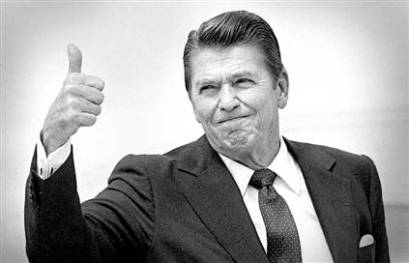I truly don’t mean to be a pain to my long-suffering students, but one exercise that elicits more scorn than it deserves is called “Especially Powerful.”
It consists of everyone rising to a standing position and striking a confident stance with feet shoulder-width apart and arms outstretched to either side, palms turned upward.
Picture it. This is a critical and powerful pose.
Power Personified
Then visualize a slight tilt of the head up and, in unison and in the best tradition of the deep-voiced Darth Vader, everyone repeats after me . . . “I feel especially powerful today!”
Several times.
“I feel especially powerful today!”
I’m not satisfied until the room reverberates with the appropriate tone and volume, indicating a robust and vibrant embrace of the exercise and what we’re trying to accomplish.
Which is . . . what?
Why do I engage in what, to some, might appear gimmicky or cute?
First, I don’t do cute. Second, the exercise accomplishes several superb physiological goals that improve a range of characteristics associated with business presenting.
Voice . . . stance . . . posture . . . confidence . . . poise.
In short, much of what we call body language.
Body Language
We hear in some circles that nonverbal communication – your body language – comprises more than 50 percent of your message. Some studies contend that it comprises more than 70 percent.
For no other reason than this, we should be concerned with the messages we transmit with our posture, our expressions, our gestures. Yes, body language is critical to conveying your message.
But it is essential for another equally important reason.
It’s a reason not generally well-known or understood, and it constitutes a secret that I’ve utilized with my presentation students for years to invest them with confidence and new-found presentation power. Its core idea stretches back well more than a century, to one of the world’s first theories of emotion: James-Lange Theory.
William James and the Danish physiologist Carl G. Lange developed the theory independently of each other in the 1880s.
Here’s a taste of the real thing from Mr. James himself:
“My theory … is that the bodily changes follow directly the perception of the exciting fact, and that our feeling of the same changes as they occur is the emotion. Common sense says, we lose our fortune, are sorry and weep; we meet a bear, are frightened and run; we are insulted by a rival, are angry and strike. The hypothesis here to be defended says that this order of sequence is incorrect … and that the more rational statement is that we feel sorry because we cry, angry because we strike, afraid because we tremble …
Without the bodily states following on the perception, the latter would be purely cognitive in form, pale, colorless, destitute of emotional warmth. We might then see the bear, and judge it best to run, receive the insult and deem it right to strike, but we should not actually feel afraid or angry.”
And if you aren’t satisfied with the narrative of a 19th Century social scientist you never heard of, then take the theory of Charles Darwin, who in 1872 was one of the first to speculate that your body posture can have an effect of generating emotions rather than simply reflecting them.
The free expression by outward signs of an emotion intensifies it. On the other hand, the repression, as far as this is possible, of all outward signs softens our emotions . . . . Even the simulation of an emotion tends to arouse it in our minds.
So what does this have to do with powerful business presenting?
Everything.
We generally believe that our emotions affect our body language, and we ourselves have experienced the effects of stage fright. Emotions influence the way you stand, the way you appear to your audience. They influence what you say and how you say it.
So if we feel stage fright and lack of confidence, our body language telegraphs that. Moreover, once we become conscious of the effects of our fears, they worsen, and we get caught in a downward spiral of cause-and-effect.
But what if we could reverse that cause-and-effect? What if we could, say, strike a confident pose and suddenly find ourselves infused with confidence? Impossible, eh?
But James-Lange Theory suggests that very thing, that you can reverse the process.
Turn Negative Energy into Positive
You can use your gestures, movement, posture, and expression to influence your emotions. You can consciously affect body language associated with the emotion you want to experience – namely, confidence – and so gain confidence.
This means that we shou ld lay the groundwork for our emotions to reflect our body language and our posture. Consciously strike a bearing that reflects the confident and powerful speaker you want to be.
ld lay the groundwork for our emotions to reflect our body language and our posture. Consciously strike a bearing that reflects the confident and powerful speaker you want to be.
This may sound too easy and leave you asking “what’s the catch?”
No, there’s no catch. And now that recent research has scientifically confirmed the dynamic I just described, the secret is out.
Several theories later and after many attempts to debunk James-Lange Theory, the most recent research at Harvard University and the Kellogg School of Business would seem to give Mr. James and Mr. Lange the proverbial last laugh.
A 2010 Harvard study substantiated James-Lange Theory and found that power posing substantially increases confidence in people who assume them while interacting with others. The Kellogg study early this year yielded the same findings.
In short, the way you stand or sit either increases or decreases your confidence. The study’s conclusion is unambiguous and speaks directly to us.
Our results show that posing in high-power displays (as opposed to low-power displays) causes physiological, psychological, and behavioral changes consistent with the literature on the effects of power on power holders — elevation of the dominance hormone testosterone, reduction of the stress hormone cortisol, and increases in behaviorally demonstrated risk tolerance and feelings of power.
This finding holds tremendous significance for you if you want to imbue your presentations with power. In our 21st Century vernacular, this means you should stand the way you want to feel. Posing with power – “I feel especially powerful today!” – improves your entire presentation delivery tremendously and in ways you’ve likely not imagined.
Power Posing can flood your system with testosterone and can suppress stress-related cortisol, so you actually do invest yourself with confidence and relieve the acute anxiety that presentations sometimes generate.
The lesson here is to affect the posture of confidence. Square your shoulders. Fix a determined look on your face. Speak loudly and distinctly.
Extend your arms to either side and take up lots of space.
Seize the emotional energy flow and make it work for you.
And remember . . .
“I feel especially powerful today!”
For especially powerful guidance on delivering a sterling presentation every time, consult The Complete Guide to Business School Presenting.














 But the book, The Presentation Secrets of Steve Jobs, is more about Steve Jobs than about you. It’s more about Steve Jobs than about presentation secrets that you can actually use.
But the book, The Presentation Secrets of Steve Jobs, is more about Steve Jobs than about you. It’s more about Steve Jobs than about presentation secrets that you can actually use.





























